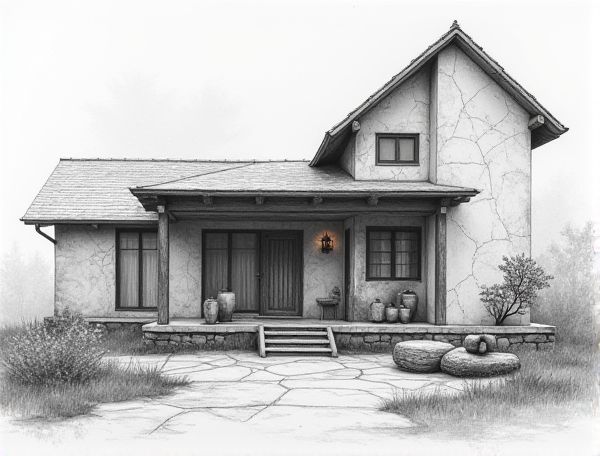
Photo illustration: Wabi-sabi home design with cracked earthenware
Embrace the beauty of imperfection in your home with Wabi-sabi design, where cracked earthenware pieces add character and a natural, lived-in charm to your space. Discover how to integrate these unique elements seamlessly by reading more in the article.
Embracing Imperfection: The Essence of Wabi-Sabi
Wabi-sabi celebrates the beauty found in natural imperfections, emphasizing aged wood grains, weathered textures, and asymmetrical forms that create a serene, authentic living space. This design philosophy embraces simplicity and impermanence, allowing homeowners to connect deeply with the organic, imperfect elements of their interiors.
Cracked Earthenware: Beauty in Brokenness
Cracked earthenware adds unique character and rustic charm to your home design, showcasing how imperfection can enhance aesthetic appeal through natural textures and weathered patterns. Embracing these broken elements transforms ordinary spaces into soulful environments rich with history and artistic value.
Natural Materials in Wabi-Sabi Home Design
Natural materials like reclaimed wood, stone, and bamboo are fundamental in Wabi-Sabi home design, emphasizing authenticity and the beauty of imperfection. These elements create a calming, organic atmosphere by showcasing textures and weathered finishes that celebrate nature's unique charm.
The Art of Repair: Kintsugi and Emotional Value
Kintsugi, the Japanese art of repairing broken pottery with gold lacquer, transforms flaws into unique features, symbolizing resilience and beauty in imperfection; integrating this philosophy into home design fosters emotional value by celebrating the history and stories embedded in spaces. Embracing Kintsugi-inspired repairs elevates damaged elements to focal points, enriching the home's narrative and deepening emotional connections through visible restoration.
Earthy Color Palettes for Serene Spaces
Earthy color palettes featuring warm browns, muted greens, and soft beige tones cultivate serene spaces by grounding interiors in nature-inspired hues. Incorporating shades like terracotta, olive, and sandy taupe enhances warmth and promotes a calming atmosphere in living rooms and bedrooms. These colors harmonize well with natural materials such as wood, stone, and linen, creating cohesive, tranquil environments ideal for relaxation and mindfulness.
Mindful Minimalism: Less is More
Mindful minimalism in home design emphasizes intentional simplicity by decluttering spaces and selecting multifunctional furniture to enhance functionality and tranquility. This approach prioritizes natural light, neutral color palettes, and quality materials, creating an environment that fosters relaxation and mental clarity.
Integrating Cracked Ceramics into Everyday Decor
Cracked ceramics offer a unique texture and visual interest that enhances contemporary home design, inviting organic imperfection into polished spaces. Incorporating these pieces as vases, bowls, or wall art adds depth while maintaining functionality due to their durable glaze treatments. Emphasizing natural color palettes and complementary materials like wood or metal highlights the ceramics' intricate fractures, creating harmonious, tactile decor elements.
Creating Harmonious Spaces with Texture
Incorporating diverse textures such as soft fabrics, smooth surfaces, and natural wood enhances the sensory experience and adds depth to home interiors. Layering tactile elements like plush rugs, woven baskets, and velvet cushions creates visual interest and promotes balance within living spaces. Thoughtful texture combinations cultivate a harmonious atmosphere that elevates comfort and aesthetic appeal.
Finding Balance Between Chaos and Order
Achieving harmony in home design involves strategically blending clutter-free organization with personalized elements that express individuality. Thoughtful placement of furniture and decor enhances functionality while maintaining a dynamic, inviting atmosphere.
Sustainable Living Through Wabi-Sabi Principles
Embracing Wabi-Sabi principles in home design fosters sustainable living by prioritizing natural materials, simplicity, and imperfection, which reduces waste and environmental impact. Incorporating aged wood, handmade ceramics, and organic textiles supports eco-friendly sourcing while creating a harmonious, calming space. This philosophy encourages mindful consumption and appreciation of the beauty in impermanence, promoting long-term sustainability in residential environments.
 homedesy.com
homedesy.com